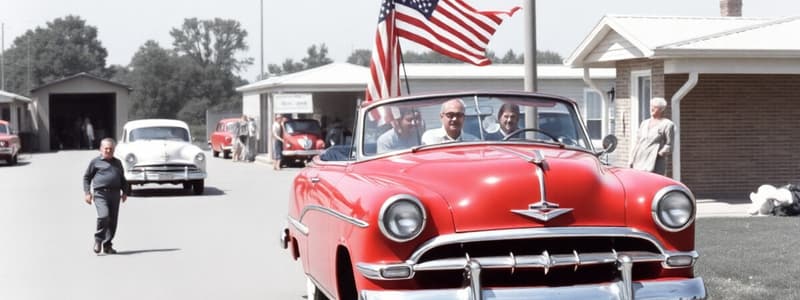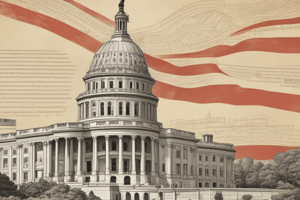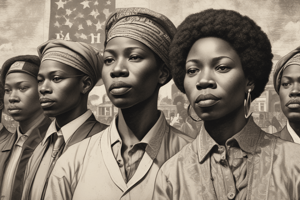Podcast
Questions and Answers
What was a significant economic shift in the United States immediately following World War II?
What was a significant economic shift in the United States immediately following World War II?
- A decline in factory jobs due to automation.
- Increased government control over manufacturing.
- A transition from wartime production to consumer goods. (correct)
- A shift towards agricultural self-sufficiency.
The conclusion of World War II resulted in an economic downturn due to decreased government spending.
The conclusion of World War II resulted in an economic downturn due to decreased government spending.
False (B)
What demographic event that occurred post-World War II significantly impacted the demand for housing and other goods?
What demographic event that occurred post-World War II significantly impacted the demand for housing and other goods?
baby boom
The rise in car ownership during the Golden Age of America led to the development of new types of businesses and leisure activities, such as ______ and ______.
The rise in car ownership during the Golden Age of America led to the development of new types of businesses and leisure activities, such as ______ and ______.
Match the cultural elements with their associated era in American history:
Match the cultural elements with their associated era in American history:
What impact did the increasing popularity of television have on American society during the Golden Age?
What impact did the increasing popularity of television have on American society during the Golden Age?
During the Golden Age of America, cinematic movie attendance declined due to the rise of television.
During the Golden Age of America, cinematic movie attendance declined due to the rise of television.
Name one infrastructural development that catered to motorists and facilitated cross-country travel during the Golden Age of America.
Name one infrastructural development that catered to motorists and facilitated cross-country travel during the Golden Age of America.
During the 1950s, teenage girls often wore blue jeans rolled up to show their white 'bobby socks' and ______ shoes.
During the 1950s, teenage girls often wore blue jeans rolled up to show their white 'bobby socks' and ______ shoes.
Match the fashion items with their descriptions during the Golden Age of America:
Match the fashion items with their descriptions during the Golden Age of America:
Which of the following factors contributed to the rise of large suburbs in America during the Golden Age?
Which of the following factors contributed to the rise of large suburbs in America during the Golden Age?
The Red Scare primarily targeted politicians and government officials suspected of communist sympathies.
The Red Scare primarily targeted politicians and government officials suspected of communist sympathies.
Who was the U.S. senator that played that significant role in fueling the Red Scare during the Golden Age of America by accusing many people of being communist sympathizers?
Who was the U.S. senator that played that significant role in fueling the Red Scare during the Golden Age of America by accusing many people of being communist sympathizers?
Those accused of being communists during the Red Scare were often added to a ______, preventing them from finding work.
Those accused of being communists during the Red Scare were often added to a ______, preventing them from finding work.
Match the following terms with the correct description:
Match the following terms with the correct description:
What event led to the beginning of the end of the Red Scare?
What event led to the beginning of the end of the Red Scare?
By the mid-1950s, Americans obsession to find communists had only intensified.
By the mid-1950s, Americans obsession to find communists had only intensified.
What other issues besides the Cold War influenced the United State during the Golden Age of America?
What other issues besides the Cold War influenced the United State during the Golden Age of America?
During the Golden Age of America, African Americans were forced to attend different ______ as White Americans.
During the Golden Age of America, African Americans were forced to attend different ______ as White Americans.
Match the following shows with their correct name!
Match the following shows with their correct name!
Flashcards
Post-WWII Shift
Post-WWII Shift
Period after WWII; Americans moved on, factories shifted back to usual products.
Baby Boom
Baby Boom
The period after World War II where birth rates increased significantly.
Suburban Expansion
Suburban Expansion
Residential areas that saw rapid growth, meeting postwar housing demand.
Car Ownership
Car Ownership
Signup and view all the flashcards
U.S. Route 66
U.S. Route 66
Signup and view all the flashcards
Rock and Roll
Rock and Roll
Signup and view all the flashcards
Television Popularity
Television Popularity
Signup and view all the flashcards
Golden Age
Golden Age
Signup and view all the flashcards
1950s Entertainment
1950s Entertainment
Signup and view all the flashcards
Teen Fashion
Teen Fashion
Signup and view all the flashcards
"Poodle" Skirts
"Poodle" Skirts
Signup and view all the flashcards
Red Scare
Red Scare
Signup and view all the flashcards
Communist Sympathizers
Communist Sympathizers
Signup and view all the flashcards
Sympathizer
Sympathizer
Signup and view all the flashcards
Joseph McCarthy
Joseph McCarthy
Signup and view all the flashcards
Decline of McCarthy
Decline of McCarthy
Signup and view all the flashcards
Segregation
Segregation
Signup and view all the flashcards
Study Notes
The Golden Age of America: Post-WWII Transition
- Following World War II, Americans were eager to move forward.
- Men returned to factory jobs, resulting in women returning home.
- Factories resumed production of common goods like cars and playground equipment.
Prosperity and Growth in the 1950s
- The war ended the Great Depression, leading to increased spending.
- The 1950s signified prosperity and new opportunities.
- The "baby boom" occurred as soldiers returned home and started families.
- Increased families spurred a need for more housing, resulting in the rapid growth of neighborhoods.
- Suburbs became a popular living choice for families.
Automobile Culture
- The car industry rebounded after wartime slowdowns.
- Modern cars were mass-produced, and owning a car became a symbol of status.
- American culture centered around automobiles due to the rise of drive-in movies and drive-thru diners.
- Road trip vacations became very popular.
- Road systems were improved to accommodate more motorists.
- US Route 66, established in 1926, spanned 2,448 miles from Chicago, Illinois, to Los Angeles, California.
- This route was significant for migrants during the 1930s Dust Bowl era
Cultural Shifts
- "Rock and roll" music replaced big band music.
- Elvis Presley and other stars gained large followings.
- Popular songs included "Hound Dog" and "All Shook Up."
Television and Entertainment
- Television became popular in the 1950s after its late 1940s debut.
- Radio’s popularity was overtaken by television.
- Families gathered to watch TV shows.
- Popular shows included "Leave it to Beaver", "Davy Crockett", "I Love Lucy", "Gunsmoke", and "The Lone Ranger."
- Roy Rogers and Dale Evans starred in over 100 movies.
- The 1950s marked the golden age for television and the US.
- In general, there was strong family life, prosperity, and moral standards.
- Epic movies like Ben-Hur and The Ten Commandments, both of which starred Charlton Heston, drew big crowds.
- Musicals such as Singin' in the Rain and Oklahoma became popular.
Fashion and Leisure
- 1950s clothing styles reflected the era's culture.
- Fashion was relatively modest.
- Teenage girls wore rolled-up blue jeans with bobby socks and saddle shoes.
- “Poodle" skirts were popular, worn with crinoline slips, fitted tops, curled ponytails, bobby socks, and saddle shoes.
- Children played stickball with toy guns and Radio Flyer wagons.
- Boys wore coonskin hats and emulated Davy Crockett.
- Girls played with hula hoops and Barbie Dolls.
- Children spent long summer days outdoors due to the lack of home entertainment systems.
The Cold War and the Second Red Scare
- The Cold War created tension and anxiety.
- Americans feared communist influence as communism spread.
- Soviet acquisition of the atomic bomb heightened worry and suspicion.
- A second Red Scare emerged amid fears of American scientists acting as spies.
- The Soviet Union had spies in America, including communist sympathizers.
- Thousands of Americans were registered members of the Communist Party.
- Many people became communists during the Great Depression, wondering whether this would have been beneficial.
- Most US communists in the '30s lost interest or became opposed after the war and Depression ended.
- The Red Scare led to investigation of entertainment industry professionals.
- Accused communists were "blacklisted" and unable to work.
- Senator Joseph McCarthy fueled the Red Scare.
- McCarthy accused anyone who angered him of being a communist, regardless of facts.
- A sympathizer is someone who backs an idea or organization.
- McCarthy's accusations against the military marked the beginning of the end of the Red Scare.
- McCarthy's televised investigation of the military horrified Americans.
- It became clear that McCarthy made up accusations, and that it was a personal vendetta.
- People were offended by attacks against war heroes.
- By the mid-1950s, people were tired of the Red Scare.
- Obsession with finding communists calmed down, while the general public had concerns of communist plots and spying.
Social Issues
- African Americans lacked the rights and freedoms of white Americans despite the end of slavery.
- Segregation caused black Americans to attend different schools, use separate facilities, and sit in certain theater seats.
- Segregation angered Americans of all races.
- The 1950s were a time of prosperity and happiness, but the country still faced several key issues such as the Cold War and segregation.
- Senator Joseph McCarthy falsely accused people of being communists during the 1950s' Red Scare.
Studying That Suits You
Use AI to generate personalized quizzes and flashcards to suit your learning preferences.




